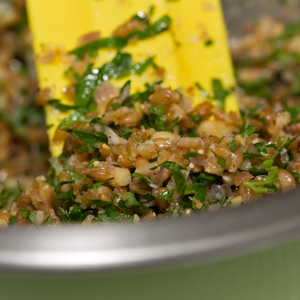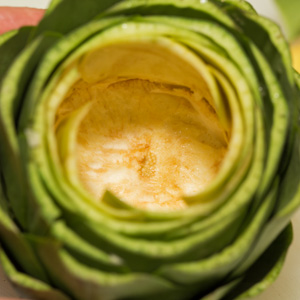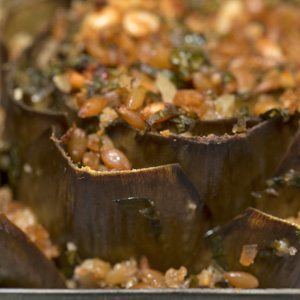Farro-Stuffed Artichokes with Bagna Cauda

introduction
With its leathery overlapping petals and pointy thorns, the globe artichoke’s attitude toward those who seek to pluck the heart of its mystery is pretty obvious. We lost the edge on three of our chef’s knives just testing this dish! There is a fair amount of splashing and chop-chop in the prep here and lots of compost material. But what an event it turns out to be! With the pale loitering of the artichoke’s mild green vegetal flavor and our party-ready Farro Piccolo informing the backdrop of a genuinely mesmerizing set of flavors—not to mention the warm dipping bath of butter, garlic, anchovy, and lemon—we went after the finished dish with both hands and a lot of after-licking. By tucking the farro filling between with leaves, the experience of pulling flesh from artichoke leaves with your teeth becomes very satisfying indeed.
Cooking Remarks
Don’t bother purchasing artichokes that show signs of battering. Look for a firm tight head, heavy weight, and no shriveling.
equipment mise en place
For this recipe, you will need a small skillet, a medium bowl and a large bowl, a sharp chef’s knife, kitchen shears, a sturdy melon baller, a 9 by 13-inch baking dish, aluminum foil, a small heavy-bottomed saucepan, and a metal skewer for testing the artichokes’ doneness.
-
for the filling:
-
1tablespoon unsalted butter
-
2tablespoons homemade fine dried bread crumbs
-
1tablespoon very finely minced shallot
-
1
-
2tablespoons toasted pine nuts, coarsely chopped
-
0.5ounce (½ cup lightly tamped) finely grated Parmesan Reggiano
-
1cup lightly packed baby arugula, coarsely chopped
-
2teaspoons juice from 1 lemon
-
¼teaspoon finely grated lemon zest
-
¼teaspoon fine sea salt
-
Freshly ground black pepper
-
2tablespoons extra-virgin olive oil
-
-
for the artichokes:
-
2large, juicy lemons, halved
-
4globe artichokes (about 10 ounces each and about 4 inches in diameter)
-
Fine sea salt and freshly ground black pepper
-
2tablespoons extra-virgin olive oil
-
1½cups vegetable stock or water
-
2 or 3garlic cloves, crushed
-
1Turkish bay leaf, broken in half
-
-
for the bagna cauda:
-
5garlic cloves
-
6tablespoons extra-virgin olive oil
-
5tablespoons unsalted butter
-
7 or 8good-quality oil-packed anchovy fillets, minced
-
3wide strips of lemon zest
-
Fine sea salt and freshly ground black pepper
-
-
Make the filling: In a small skillet over medium heat, melt the butter. Add the bread crumbs, stir until evenly moistened with fat, and cook, stirring frequently, until the crumbs are light golden, about 5 minutes. Add the shallot and continue to cook, stirring occasionally, until the shallot has softened and the crumbs are browned and fragrant, about 3 minutes longer (fig. 1.1). Pour into a medium bowl and let cool to room temperature.
-
When the bread crumbs are cooled, add the farro, pine nuts, Parmesan Reggiano, arugula, lemon juice and zest, salt, and pepper to taste. Toss to combine, and then drizzle with the olive oil and toss again until evenly moistened (fig. 2.1). Set the filling aside until you’re ready to stuff the artichokes
-
Prepare the artichokes: Adjust an oven rack to the middle position and heat the oven to 400 degrees. Fill a large bowl with cool water. Squeeze the juice from the halved lemons into the water and drop in the spent halves. With a sharp chef’s knife, trim the artichoke stem flush with the base and make sure that the head sits level and stably on the base. (The stems can be peeled and cooked for eating, if you like; otherwise compost them.) Set the artichoke on its side and lop off the top one-third; the purple-tinged inner sanctum should be exposed. With kitchen shears, snip off the thorny tips on the leaves. Using both hands, loosen the layers of leaves by splaying them (no need to be gentle when doing this—fresh artichokes are hardy) (fig. 3.1), and then using a sturdy melon baller, dig out the core, including the fuzzy choke that covers the heart. This will take some doing, but try to work quickly so that the artichoke doesn’t discolor severely; sprinkle some lemon juice in the center as you work, if you like. The artichoke should be left with an opening that’s about 1¼ inches wide (fig. 3.2); if needed, scrape out more of the innermost leaves. Drop the artichoke in the acidulated water and repeat with the remaining three.
-
Once all the artichokes have been cleaned, remove them from the water; hold them upside down to drain and shake to remove excess moisture. Sprinkle salt and pepper into the center of each artichoke. Spoon filling into each, dividing it evenly and packing it in firmly but not too tightly; also spoon some filling between the leaves (fig. 4.1). Set the stuffed artichokes right side up in a 9 by 13-inch baking dish and drizzle each with 1½ teaspoons of olive oil. Pour the stock into the baking dish, toss in the garlic cloves and bay leaf pieces, and put two of the lemon halves from the acidulated water into the dish. Cover tightly with aluminum foil and bake for 50 minutes.
-
Remove the foil and continue baking until the artichokes are browned and a metal skewer inserted through the filling into the base of the largest artichoke meets no resistance, 10 to 15 minutes longer. Let the artichokes cool in the baking dish for about 10 minutes (fig. 5.1).
-
Make the bagna cauda: While the artichokes bake, peel the garlic cloves and cut them in half lengthwise; if there’s a germ at the center, pry it out and discard. Slice the garlic clove halves very thinly. In a small heavy-bottomed saucepan, combine the sliced garlic, olive oil, butter, and anchovies and set the pan over medium heat. Cook, stirring frequently and adjusting the heat as needed to maintain a gentle but steady bubbling action, until the garlic has softened (but not browned), the anchovies have broken down, and the flavors have melded, about 15 minutes. Season with salt and pepper and drop in the strips of lemon zest. Cover to keep warm and set aside off the heat until you’re ready to serve.
-
Transfer the artichokes to serving plates. Remove the lemon zest from the bagna cauda and spoon the sauce into individual small dipping bowls or ramekins, making sure each portion has bits of garlic and anchovy. Serve the artichokes and bagna cauda while both are warm.
-
-
1.1

-
-
-
2.1

-
-
-
3.1

-
3.2

-
-
-
4.1

-
-
-
5.1

-